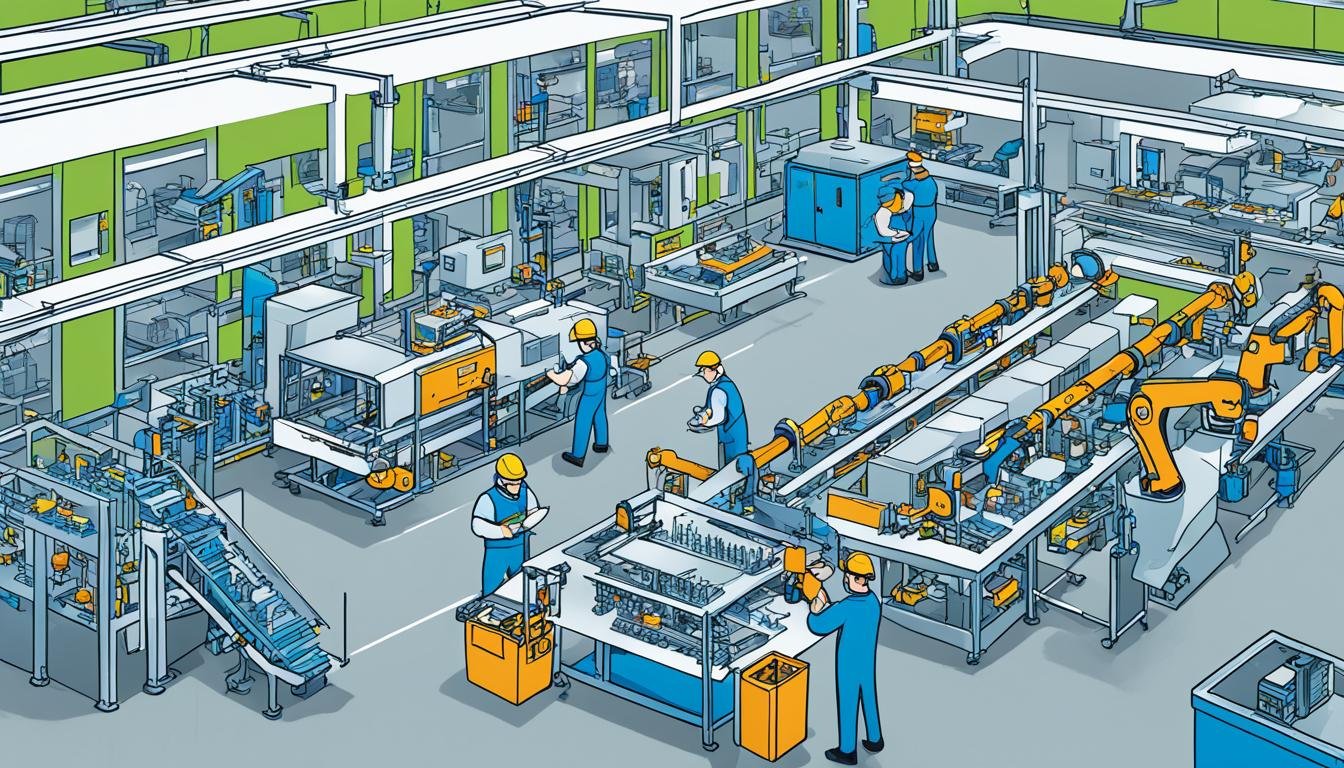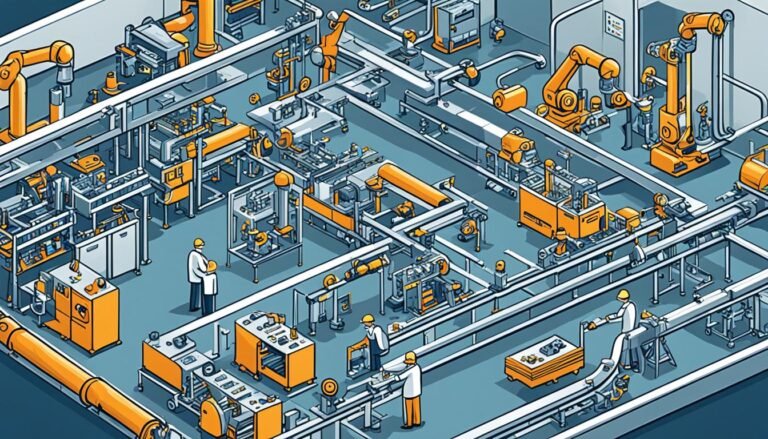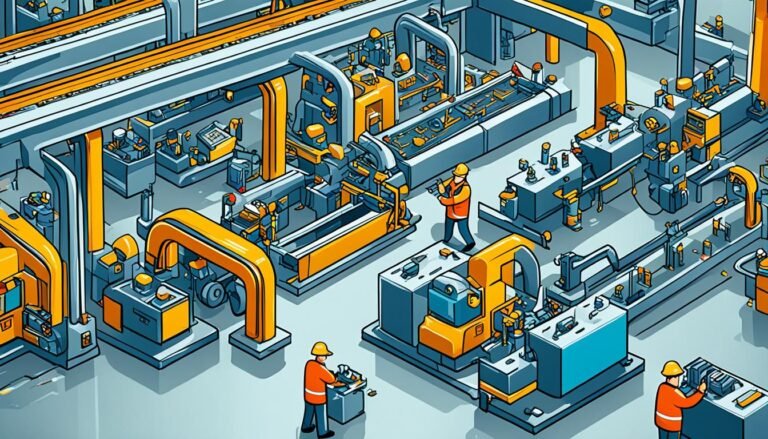Quality Control in Manufacturing: Essentials
Did you know companies can lose up to 20% of their revenue because of defective products? This fact shows how important it is to have strong quality control in manufacturing. Good quality assurance makes sure products meet standards and laws, protecting their quality.
Checking for defects during production can greatly lower the chance of bad products getting to customers. Using detailed qc manufacturing practices helps a company stand out. It builds trust with customers and gives a competitive edge.
Sales expert Kimberly McHugh, with 24 years in life sciences, says quality control is key for making great products and following the law. This part talks about the basics of quality control in manufacturing and its big role in raising product quality.
Key Takeaways
- Companies can lose up to 20% of their revenue from defective products.
- Quality control is crucial for keeping products safe and following the law.
- Checking for defects at every step in production stops bad products from getting to customers.
- Good quality assurance helps a company’s reputation and builds trust with customers.
- Thorough qc manufacturing practices are important for staying ahead and being the best in the industry.
Understanding Quality Control in Manufacturing
Quality control in manufacturing is key to making products that meet standards and customer needs. By using strict quality control processes, makers can spot and fix defects. This makes sure the final products are safe and dependable.
Definitions and Objectives
The main goal of qc manufacturing objectives is to keep and better product quality at every step of production. These goals aim to find defects early, follow industrial standards, and ensure product quality assurance. This is crucial for keeping product integrity and meeting customer satisfaction.
The Importance of Quality Control
Seeing the value of quality control processes is vital in stopping errors that could be dangerous, like in pharmaceuticals and cars. Regular quality control processes keep up with industrial standards and safety laws. They also build customer trust and protect a brand’s reputation. This focus on quality is key for lasting business success and stability.
Role in Product Integrity
Quality control is vital for protecting product integrity. It makes sure every item meets safety and performance standards. These strict steps build trust with consumers, which is key for high customer satisfaction. In short, consistent and thorough quality control processes meet business and legal requirements. They ensure products are reliable and safe for the market.
Inspection Protocols and Methods
In manufacturing, quality control inspections are key to making sure products are top-notch. These checks use strict inspection protocols to guide workers through quality tests and spot defects. By testing production batches early, companies can fix problems fast and meet industry standards.
The first step is a detailed compliance assessment to check if the product meets specs. Inspectors use many methods, like checking looks, materials, and how it works. This thorough check helps understand the product’s quality fully.
Here are some main inspection protocols and methods used in quality control:
- Visual Inspection: Looks for surface flaws and checks looks.
- Dimensional Inspection: Makes sure the product is the right size.
- Functional Testing: Checks how the product works and performs.
- Chemical Analysis: Tests for chemical makeup and safety.
Here’s a detailed table to show the different methods used:
| Inspection Method | Application | Advantages | Challenges |
|---|---|---|---|
| Visual Inspection | Finds surface defects | Quick and simple | Can vary based on inspector’s skill |
| Dimensional Inspection | Checks size | Very precise | Takes some time |
| Functional Testing | Validates performance | Makes sure it works | Needs special tools |
| Chemical Analysis | Examines chemical makeup | Very sensitive | Needs a lab setting |
By following these inspection protocols and doing careful quality testing, manufacturers can handle production batch testing well. This ensures their products always meet the quality standards.
qc manufacturing Best Practices
In the world of quality control, following best practices is key. It ensures high standards and cuts down on mistakes. Using preventive steps, fixing problems, and careful monitoring can greatly improve product quality and efficiency.
Preventive Measures and Corrective Actions
Preventive steps help spot problems early. Quality control standards let manufacturers fix weak spots before they get worse. When issues pop up, fixing them right away is crucial to meet product standards. This way, production stays consistent and reliable.
Statistical Process Control
Statistical process control (SPC) uses stats to keep an eye on production. It looks at data from different stages to find problems and trends. This helps fix issues fast, keeping quality up and making production better.
Nonconformance Management
Nonconformance management is about handling any quality issues. It makes sure problems are fixed quickly, keeping production quality high. This method tracks issues, fixes them, and checks how well those fixes work over time.
Using these best practices—like preventive steps, fixing problems, SPC, and managing nonconformance—can really boost product quality and reliability. These methods don’t just make production better. They also make customers happier and more trusting.
Essential Tools and Technologies
To keep manufacturing quality high, it’s key to use the right tools and technologies. These tools help keep things consistent and make quality checks easier. They range from detailed checklists to advanced automated systems and real-time monitoring tools.
Quality Control Checklists
Quality control checklists are key for tracking every step in making products. They make sure all important parts of production are covered. This lowers the chance of mistakes and makes products better.
Tools like FAT FINGER offer strong quality control software. They use machine learning to help with processes and keep quality up.
Automated Inspection Systems
Automated inspection systems are great for quickly finding quality problems. They use computer vision and AI to spot defects that humans might miss. Adding these systems makes production more efficient, cuts down on mistakes, and keeps quality high.
Real-Time Monitoring
Real-time monitoring lets manufacturers see how their production is doing right away. With the right tools, they can quickly spot and fix quality issues. This is key for smooth operations and keeping quality up.







